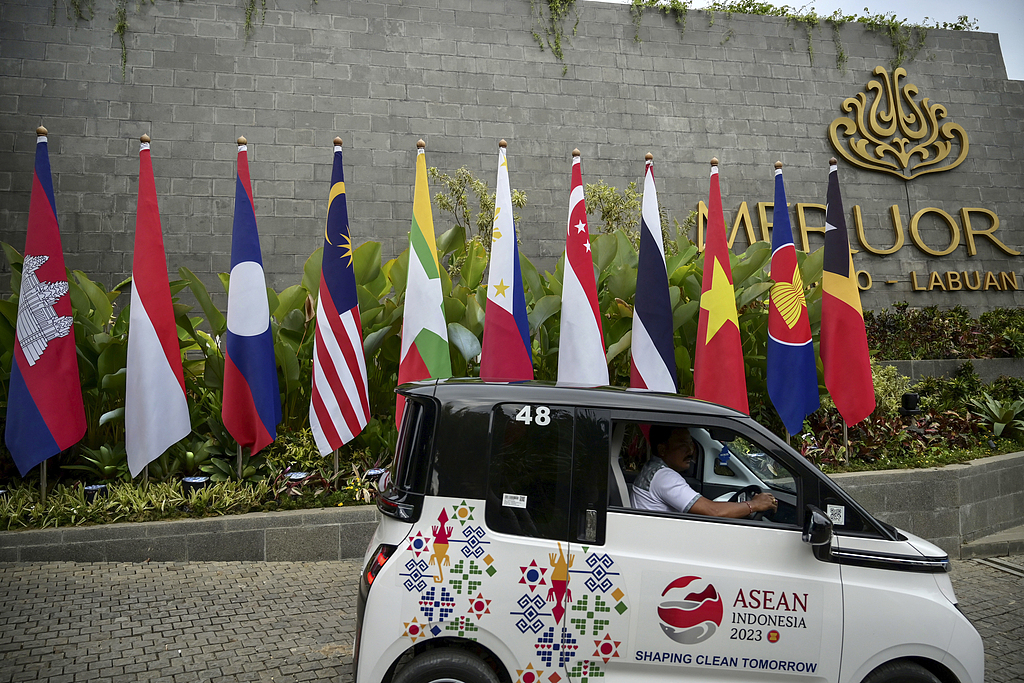
An electric vehicle moves past the flags of countries attending the Association of Southeast Asian Nations (ASEAN) meetings, displayed outside the main venue of the 42nd ASEAN Summit in Labuan Bajo, Indonesia, Tuesday, May 9, 2023. (CFP Photo)
Co-organized by the ASEAN Studies Centre (ASC) and ISEAS - Yusof Ishak Institute (ISEAS), the seminar "ASEAN Economic Community (AEC) 2045: The Next Phase of Regional Economic Integration" was held on Thursday in Singapore.
Experts from research institutions and multinational enterprises discussed the AEC blueprint 2025 achievements and setting post-2025 agenda, ASEAN economic integration measures, the implications of the region's strategies, and the challenges and chances ahead.
Mr. Allen Ng, Group Head and Principal Economist at the ASEAN+3 Macroeconomic Research Office (AMRO), noted that despite the economic progress that ASEAN has accomplished during the past two decades, its growth landscape is increasingly beset by challenges from three main secular trends, namely, aging, a global trade reconfiguration, as well as rapid technological change.
Given the obstacles ahead, ASEAN countries' ability to navigate the risks and chances the trends bring would be the premise of the long-term growth prospects of the region's economy, according to Mr. Ng. At the same time, it can harness the synergy arising from regional cooperation such as the Regional Comprehensive Economic Partnership (RCEP) and mechanisms of ASEAN plus Free Trade Agreements.
He then proposed his policy recommendations against the headwinds. Optical policies detailed four priorities in the domains of quality infrastructure, innovation and knowledge diffusion, inclusiveness, and multilateral cooperation.
Mr. Ng was still optimistic about ASEAN's development in the near future. He projected that the region is expected to keep a bright spot in the global economy - growing faster than the world average - contributing about 10 percent of global growth in 2024-2030.
Dr. Ahmad Zafarullah Abdul Jalil, Director of ASEAN Integration Monitoring Directorate at the ASEAN Secretariat, highlighted the achievements ASEAN countries have made for the ASEAN Economic Community (AEC) Blueprint 2025 from five facets. They are assessed by parameters of the economy, innovation, cooperation, people-centered consideration, and global presence.
Dr. Jalil then listed six goals of the ASEAN Economic Community's five-year strategic plan from 2026 to 2030 to envision a community of action-orientation, sustainability, bold innovation, adaptability, resilience, and collaboration.
Sharing the view from the industry, Mr. Raymond Yee, Vice President for Customs and Regulatory Affairs for DHL Express covering Asia Pacific (excluding China), focused on the nuances between the vision and the status quo in the AEC blueprint 2025.
Mr. Yee tagged effective policy measures such as the elimination of tariffs under the ASEAN Trade in Goods Agreement (ATIGA) and moves that do not hit the target and advised that the AEC Blueprint 2045 should be more pragmatic and focus on execution rather than more planning of action.
Reporter | Clonde Zhang
Editor | Steven Yuen, Monica Liu, James
















